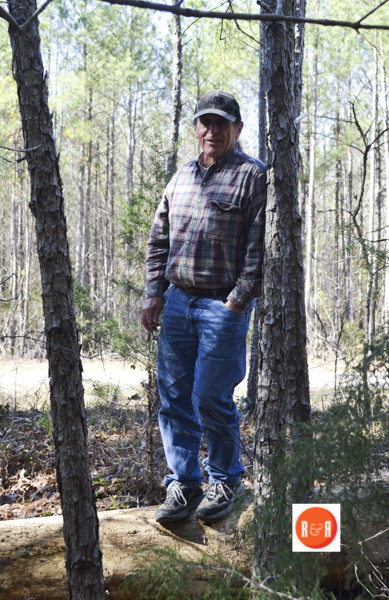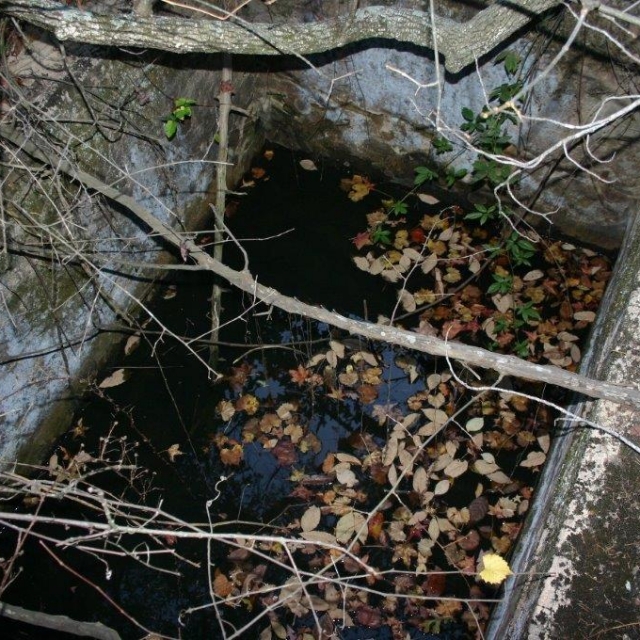City Directories and History: Built in 1848, this amazing Italian Villa home was the Lyle’s third home to be constructed on their large farm prior to the Civil War. Know as Buena Vista, this
magnificent house stood on a hill overlooking thousands of acres. Only ten years after its construction, the house was sold, to the original owner’s nephew, William S. Lyle, whose family lived in the house for decades. The home burned in 1927 and nothing of it remain in 2013 but one small brick chimney and the spring at the bottom of the hill that supplied the house with fresh water. There has long been speculation that Buena Vista was one of the earliest home in Fairfield County to have running water pumped from the spring.
On what was once Lyle property, the family also buried many of their family members. The abandoned graveyard of many Lyle members is located about a quarter mile east of the home’s location and has fallen into disrepair.
Article by Mr. Steve White – Presented at the Lyle Family Reunion Oct. 2013
One of the most magnificent and unusual of the nineteenth century homes of Fairfield County was Buena Vista. Buena Vista sat on the next hill over from Major Thomas Lyles’s home, The Oaks, about two miles from Highway 215 on the north side of the Blair Road.
Buena Vista sat on a ridge that commanded a view to the north when trees were not blocking it. On a clear day one could see almost to Chester. When I was a small boy in the early 1960’s, the view did not exist. Trees had grown up and obscured it. But in recent years, the present owner, Val Green, had cleared away the trees and restored the view. At this time the trees have again grown up and obscured the view.
Buena Vista was aptly named. ‘Buena Vista’ means good view. An oral tradition says that the house was named for The Battle of Buena Vista. The Battle of Buena Vista was fought in the Mexican-American War near Monterey Mexico in 1847. So perhaps it is just a coincidence that the house also commanded a magnificent view. Buena Vista was a two-story Italianate brick stucco house with two identical wings and a porch recessed between the two wings. It was built in 1848 by William Strother Lyles who signed the articles of secession for South Carolina. Mr. Lyles modeled Buena Vista after chateaus he had seen on a trip to France.

Author and historian Mr. Val Green standing along the old Philadelphia Wagon Road in western Fairfield Co., S.C. It was along this colonial road that many early settlers began building permanent homes. 2017
We learned from an old article in the newspaper that William Boykin Lyles, nephew of William Strother Lyles and oldest son of Thomas Minter Lyles of Ivy Hall, also lived at Buena Vista. In fact, I found a deed of 1858 in which W.S. Lyles sold the property at Buena Vista to William Boykin Lyles, his nephew. William Strother Lyles died in 1861. William Boykin Lyles was then killed at Seven Pines in 1862. We think that Georgiana must have stayed on at Buena Vista for awhile, but we don’t know how long. When she sold the property in 1879, she refers to it as the place where I formerly lived, Georgiana Lyles sold the property at Buena Vista to Josephine Ladd, daughter of the famous school teacher and artist, Catherine Ladd. Catherine Ladd lived there from 1880 until her death in 1899. Prior to Catherine Ladd’s death, Josephine Ladd sold the property to Trezvant Feaster in 1894. We believe that Catherine Ladd stayed on at Buena Vista as his tenant until her death in 1899.
Trezvant Feaster’s daughter Miss Florence Feaster inherited the property. She lived there from June through September every year and spent the remaining months in Daytona, Florida. Her descendant, Mr. Vernon Ragsdale reports that when met at the train, Miss Feaster would have five or six trunks including even her pots and pans. During the last years of her life, Miss Feaster was no longer up to making the yearly trip to Buena Vista and stayed in Daytona. She sold Buena Vista to Maysie Lyles Lyons, granddaughter of W.S. Lyles and wife of Rev. John Sprole Lyons, minister of Salem Presbyterian Church, in 1924. Miss Feaster died in 1929.
The Lyons’s rented out rooms in the house. One of their tenants was Phillip Crotwell, principal of the newly-opened Monticello School at Salem Crossroads. Buena Vista burned to the ground in 1927 due to sparks from the chimney getting into the shake roof. It is said that Mr. Crotwell had to jump from the second story to get out. The only thing saved from the fire was a silver bowl which is now in the possession of the Lyons’s grandson John Collins.
We did learn from an old article from the newspaper, however, that Rev. Lyons was in Jacksonville, Florida at the time of the burning. He had there, in his possession, the burial flag of the 1st South Carolina Regiment, which was, thus, saved from the fire. John Collins, a descendant of Rev. Lyons, informed me that this was not a Confederate flag as I had assumed. Instead it was made by ladies in France or Belgium during World War I when Rev. Lyons was a chaplain. The flag is still with the family. We also learned that Rev. Lyons had accepted a position as religious director of schools in Asheville, NC prior to the fire and had, within two hours of the fire, almost completed a sale of the property. A valuable library of several thousand volumes as well as some antique furniture, including a heavy four-poster bed were lost in the fire.
The Lyons’s sold the property to Jasper Owens, a mail carrier from Blairs, who married Mary Drew, his second wife. Mr. Owens built a house near the site of the now burned Buena Vista. Mr. Owens died in the mid 1930’s leaving three children by his second wife. Mary Drew Owens subsequently married my mother’s oldest brother John L. Dickey Jr. I played all over the place as a child, completely oblivious to its history.
Buena Vista had running water as far back as the 1850’s. It was very unusual for houses to have running water in the nineteenth century. The water was supplied by a ram pump that pumped water from a spring which was a considerable distance from the house and much lower in elevation. Ram pumps use no electricity. They harness and multiply the force of water running downhill, to generate the pressure to pump the water. I recently visited the spring and the site of the pump with John Owens who lived on the property from the 1930’s to the 1960’s. The holding tank at the spring head still exists. From there, the water flowed downhill about 75-100 feet to the pump. We believe we know the exact location of the pump, John said that in his youth there were still some parts of the pump there. The outflow pipe that supplied water to the house is still visible above ground from the site of the pump. We don’t really know what the plumbing arrangement was at the house. We do know that there was an underground cistern near the house. But we don’t know whether it was connected with the pump or only accumulated rainwater from the roof of the house. It would seem there would have to be some regulating mechanism in the system because the pump would have pumped water continuously, but the water would not have been drawn constantly.
There were two stone grape arbors at the site of the house when I was a boy in the 1960’s. One of them has been removed in recent years. In late winter and early spring an expanse of the yard was covered with daffodils. We don’t know how or when they originated, but they have been there as long as anyone alive now can remember. We speculate that perhaps they were of a species that multiplies because they seem like too many to have been planted one by one. The brick smokehouse that still stands on the site was probably built by Jasper Owens in the 1920’s or 30’s, possibly from bricks from the original house. There was also a barn out back which was still in use during the time of my childhood. John Owens, son of Jasper Owens born 1934, says that there were two buildings, apparently built at the same time as Buena Vista, still standing during his time. There was one large building with a large room and fireplace flanked by two smaller rooms. He believes this was the kitchen or possibly servants’ quarters. And there was a smaller building that appeared to be the carriage house and some kind of shop. The reason he believes these building were built at the same time as Buena Vista is that the sills were very big and make of hand-hewn oak put together with pine wooden pegs. The ruins of one of these buildings, probably the carriage house, are still visible at the site today.
Historian C.G. Davidson wrote in his book, The Last Foray – Lyles, Thomas Minter of “Lyles Quarter” plantation. Born Oct. 13, 1811 (S.C.); married June 20, 1832, Eliza Roselin E. Peay (Feb. 16, 1816-Dec. 25, 1897); died Feb. 7, 1902. Education: College of S.C., A.B. 1831. Baptist and Deacon at Rock Creek. Slaves 184 (Fairfield District).
Stay Connected
Explore history, houses, and stories across S.C. Your membership provides you with updates on regional topics, information on historic research, preservation, and monthly feature articles. But remember R&R wants to hear from you and assist in preserving your own family genealogy and memorabilia.
Visit the Southern Queries – Forum to receive assistance in answering questions, discuss genealogy, and enjoy exploring preservation topics with other members. Also listed are several history and genealogical researchers for hire.
User comments welcome — post at the bottom of this page.
Please enjoy this structure and all those listed in Roots and Recall. But remember each is private property. So view them from a distance or from a public area such as the sidewalk or public road.
Do you have information to share and preserve? Family, school, church, or other older photos and stories are welcome. Send them digitally through the “Share Your Story” link, so they too might be posted on Roots and Recall.
User comments always welcome - please post at the bottom of this page.









What a wonderful article and history of the place where I grew up. We just loved it as “home.”
Pinkey Dickey Peake